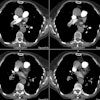AJR Am J Roentgenol 1995 Jun;164(6):1369-1374. Detection of pulmonary embolism in patients with unresolved clinical and scintigraphic diagnosis: helical CT versus angiography.
Goodman LR, Curtin JJ, Mewissen MW, Foley WD, Lipchik RJ, Crain MR, Sagar KB, Collier BD
OBJECTIVE. This study was designed to prospectively compare helical CT with pulmonary angiography in the detection of pulmonary embolism in patients with an unresolved clinical and scintigraphic diagnosis. SUBJECTS AND METHODS. Twenty patients with an unresolved suspicion of pulmonary embolism were evaluated with contrast-enhanced helical CT and with selective pulmonary angiography. An average of 11 hr separated the two studies. The CT scans were obtained during one 24-sec or two 12-sec breath-holds. CT scans were interpreted without knowledge of the results of scintigraphy or angiography. Selective pulmonary angiograms were obtained with knowledge of the findings on the ventilation/perfusion scan only. The sensitivity and specificity of CT were compared with those of angiography for central vessels (segmental and larger) only and for all vessels. RESULTS. Eleven of the 20 patients had proved pulmonary embolism (seven in central vessels and four in subsegmental vessels only). When only central vessels were analyzed, CT sensitivity was 86%, specificity was 92%, and the likelihood ratio was 10.7. However, when subsegmental vessels were included, CT results were 63%, 89%, and 5.7, respectively. CONCLUSION. In our subset of patients, helical CT was only 63% sensitive. Subsegmental emboli are difficult to diagnose. Pulmonary angiography remains the study of choice. CT has a limited role in the evaluation of acute pulmonary embolism.
PMID: 7754875, MUID: 95274497







